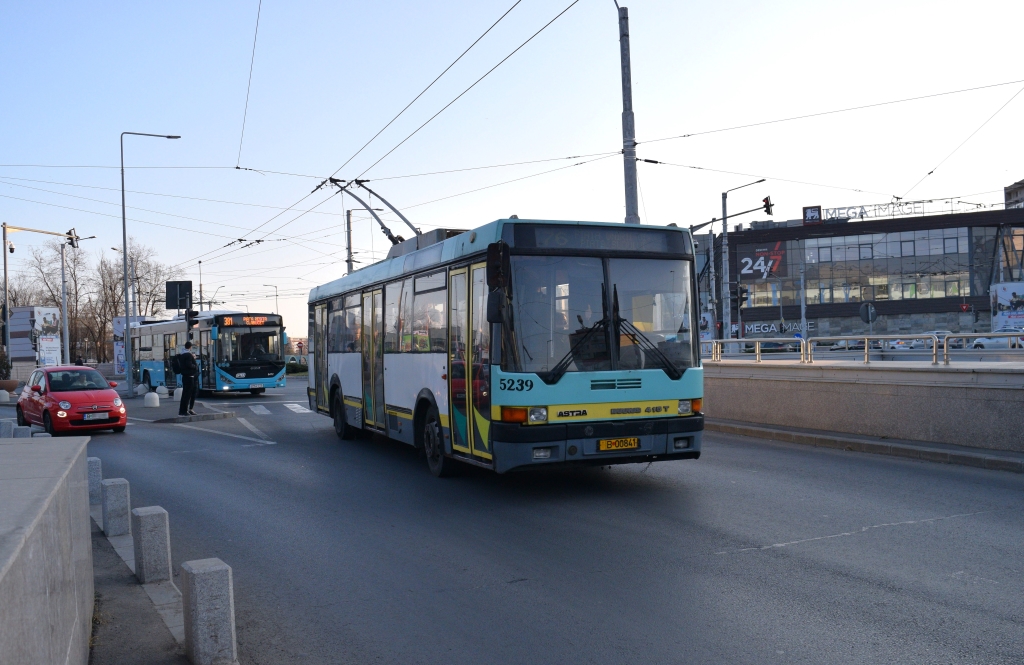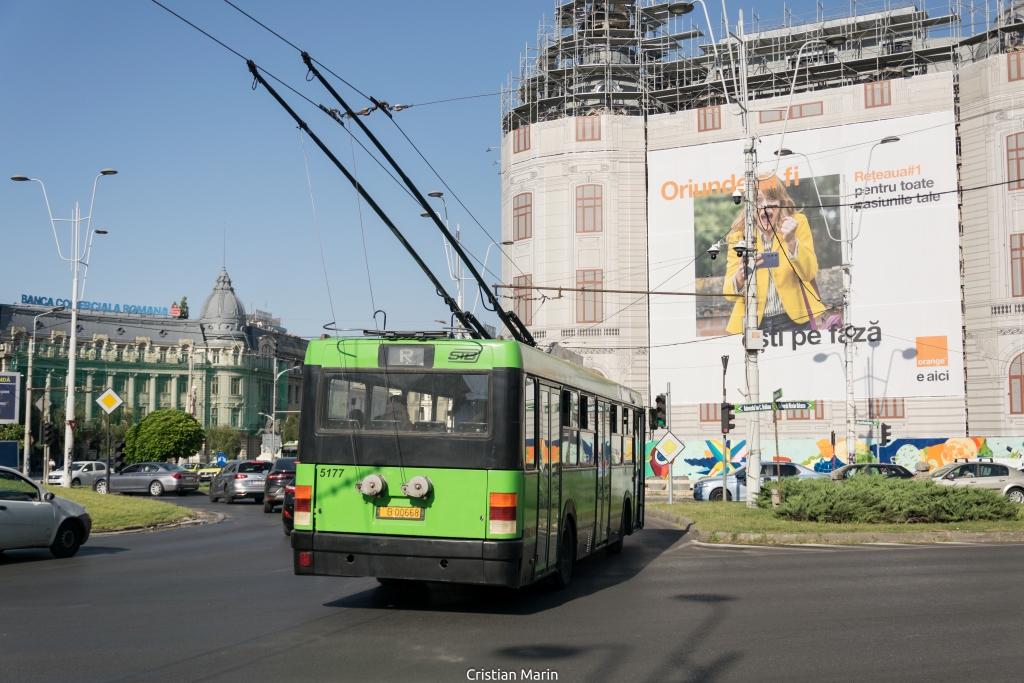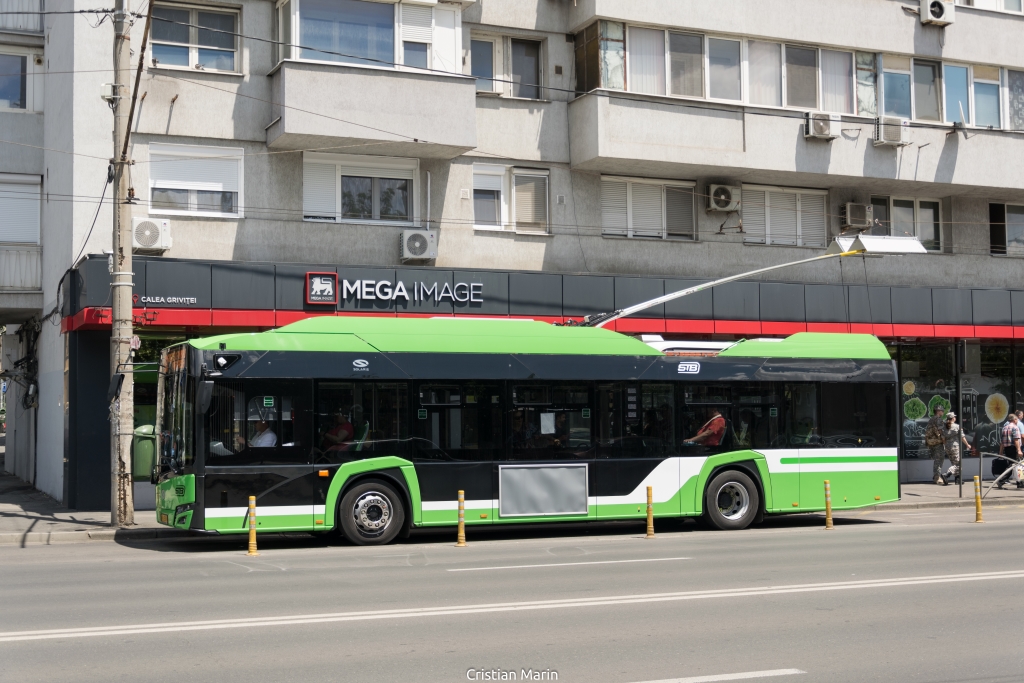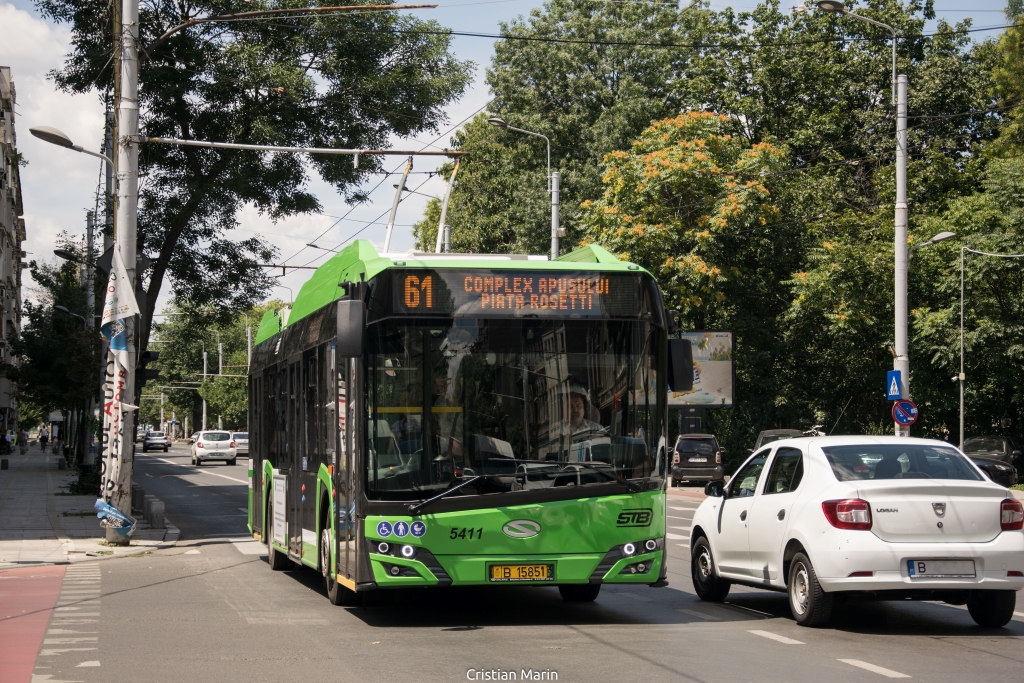
Like stories from other parts of the world, the condition of the trolleybus network in Bucharest, Romania started to look pretty bleak in the last decade. No new investments in the overhead wire infrastructure were made for 15 years, with the last modernization of a segment taking place in 2007 and the opening of a new one in 2008 as a part of the plan to reconnect the isolated subnetwork located in the south of the city (Berceni neighbourhood). The lack of maintenance, especially of vital parts like switches and crossings, made the operation of the trolleybus increasingly difficult, reducing the commercial speed and making trolleybuses less attractive to the public, compared to the parallel bus routes.
The condition of the trolleybus fleet deteriorated during the same period, with the vehicles from the oldest model Ikarus 415T (high floor) already reaching an age between 22 and 27 years, overpassing the operation expectancy. Many of the trolleybuses were withdrawn in the recent years, due to a failure of various equipment, with about 55 still being operational at the beginning of 2024. A more recent acquisition took place in 2007, when 100 full-low floor Irisbus Citelis trolleybuses arrived, but in recent years they were also affected by defects, with 2 units suffering total damage after catching fire.


The total size of the fleet decreased from 302 vehicles in 2010 to 265 in 2022. The same trend can be seen for the daily operating fleet that decreased from 215 to 167.
The sky-rocketing evolution of the electric batteries and the appearance of electric buses determined some persons in charge of Bucharest’s transportation to consider the gradual replacement of trolleybuses with vehicles based on the newer technology. There, the decision to host hybrid buses in the trolleybus depot of Bujoreni has been made, with further plans to convert at least some of the depots into bases for electric bus operation.
The network
The total size of the network is also in decline. It decreased from 76 km in 2010 to 67 km currently, with 2 segments being dismantled. In both cases it happened due to the reconstruction of streets. In one case it was considered that the trolleybus is no longer necessary, as the fifth metro line started to operate instead in the neighbourhood of Drumul Taberei. In the second case, the reconstruction project simply did not plan what would happen with the trolleybus once the street is rebuilt and consequently the trolleybus terminal Barajul Dunării (Titan neighbourhood) disappeared. What started as a suspension of line 92, became the definitive closure.
At the moment the situation of another trolleybus segment is uncertain. For the last 2 years the network at the terminal Alexandru Obregia of the trolleybus line 74 (currently suspended) has been dismantled in order to make room for a new overground passage named “Europa Unită”. As in the case of line 92, there are no official plans or answers regarding the reconstruction of the trolleybus loop.
The perspective of continuing works for the fifth metro line in the next decades on an East-West axis through the city centre (Piața Universității) that overlaps with most of the trolleybus lines, creates perspectives of further closures in the future, as clearly some lines may become redundant. The scenario from the 1980s when the dictator Ceaușescu opened the second metro line on the main North-South corridor of the city and closed all parallel trolleybus routes might happen again on the East-West corridor if an unobstructed vision for the future of the trolleybus in Bucharest is not considered.

New trolleybuses from Solaris
To all this gloomy situation, a glimmer of hope appeared in February 2019, when finally, the City Hall organized a tender to acquire a batch of 100 trolleybuses equipped with auxiliary power unit that would allow them to operate partially off-wire. Unfortunately, things did not go smoothly. The initial tender was won by the consortium of Bozankaya Otomotiv Makina and Sileo GMBH. A contract was signed in March 2020, only to be terminated by the City Hall half a year later, as the producer failed to present in the required time a homologation certificate for the trolleybus model. After this setback, the City Hall was able to restart the tender in August 2022, and the winner was announced in December the same year: Solaris Bus & Coach sp. z o.o. with the model Trollino. This time the order proceeded successfully.
The model of Solaris Trollino ordered by Bucharest has the following features:
- 12 m length
- capacity of 90 passengers at a time, 25 of whom will be seated
- 3 access doors
- ramp with mechanical drive to facilitate access for disabled people
- powered by a 160-kWh traction motor
- equipped with Solaris High Power batteries with a capacity of 60 kWh, which will enable them to cover distances of up to 20 km at a time without connection to overhead wires
- traction inverter produced by Medcom
- air conditioning system
- various ITS equipment for surveillance, passenger information both audio and video, counting travellers, WI-FI
- USB chargers
Also, the vehicles benefit from a 5-year full warranty (or 300.000 km) with all planned maintenance activities included (including consumables, spare parts).




The deliveries started in January 2024 and the first vehicles went into service on 17th February on line 93 (Valea Argeșului terminal – Gara de Nord loop). Benefiting from an auxiliary power source, the new trolleybuses made a large-scale reconfiguration of the network for the first time in many years possible, as they need to run under overhead wires only part of the route.
Plans regarding changes of lines were made even years earlier as part of the acquisition project, involving lines 62, 70, 73, 74, 76, 93, 97. Most of them considered small extensions of lines by maximum 2 kilometres, but the benefits of those changes were questionable. Some of them had little chance to bring improvements, as the passenger demand was already satisfied adequately by the existing transport offer. Other projects looked a bit trivial, like the usage of trolleybuses with 20 km autonomy for line 97 where only the proposed terminal at Piața Romană lacked a few meters of infrastructure.
The infrastructure
Fortunately, the initial plans were discarded, and more ambitious projects were implemented after the reception of the new trolleybuses. The main purpose of the changes was to maximize the benefits of using electric vehicles by replacing, wherever it is possible, the diesel buses operating or overlapping routes. High demand bus lines in the city centre like 133, 201 or 336 were cancelled and trolleybus lines are now running in their place.
The case of bus line 336 and trolleybus line 61 is particularly interesting, as for decades they overlapped 87% of the routes. The lack of 500 meters of overhead wires in order to reach the terminal Complex Comercial Apusului in a densely built residential area with an agro-food market in the immediate proximity made it impossible for trolleybuses to operate on the very popular bus line. This has finally been achieved with trolleybus line 61 having now exactly the same route as previously mentioned 336. The fleet on this line is currently mixed, with a few buses operating due to the lack of enough trolleybuses.
In the other 2 cases of bus lines 201 and 133, they were incorporated into the trolleybus lines 90 and 97, by extending the latter. Line 90 had about 3 km with 201 in the city centre in common. Until the extension, the 90 line had the problem of lacking a proper terminal on the western side of the route so it had to make a large loop through an area with low transport demand. After incorporating line 201, it also received a boost in the size of the operating fleet, the equivalent of the number of vehicles from the former bus line, improving its overall frequency. The extension of line 97 was by a far larger scale. Previously, the routes of trolleybus 97 and bus line 133 did not overlap, but only intersected themselves in the proximity of their terminals in the area of Gara de Nord, the main railway station of the city. By incorporating line 133, 97 practically doubled its length. On this occasion, a small section of the trolleybus network not used since 2002 was reactivated on Calea Griviței and Bulevardul Dacia, between the streets Polizu and Calea Victoriei.
Another trolleybus line that was extended in order to replace bus lines is 93, but here the changes were made gradually, and no bus lines were replaced totally. In February, the line was slightly extended in the West to the terminal Cartier Constantin Brâncuși, replacing there the bus line 168, which was shortened to Valea Ialomiței terminal. Three months later, the line was extended from the other end, replacing the bus line 105 between Gara de Nord and the terminal Piața Presei. Line 105 was instead shortened to Gara de Nord. Thus, on Calea Griviței (between Gara de Nord and Piața 1 Mai) only trolleybus lines can be found.
The most recent change involved the creation of a new trolleybus line number 63, that replaces the bus line 136 on most of the route between Pod Izvor and Autogara Militari. From the 10 km new route, about half is under overhead wire. By implementing this measure, significant parts of Iuliu Maniu boulevard are operated only by trolleybus lines.
Not all changes that were planned in the last months went so smoothly as expected. The extension of the line 70 which was supposed to offer a better coverage of the rich neighbourhood of Cotroceni was cancelled after residents’ protests.
In the southern part of the city, the segregated subnetwork in the neighbourhood of Berceni was damaged two years ago in May 2022 when a fire destroyed an electric substation that supplied power for the network in the Piața Sudului area. Since then, both tramway and trolleybus operation have severely been limited, with only one trolleybus line still being functional (76) and the other two suspended (73, 74). Any plans for this part of the city are on hold until the substation is restored, hopefully next year. Before the fire accident, there were proposals that even all 3 lines of the subnetwork to receive Solaris Trollino trolleybuses. Extensions of these lines are highly necessary, as they fail to reach in a proper manner the city centre (the trolleybus terminal is just outside of Piața Unirii transportation hub) and have far lower demand than the overlapping bus lines.
Conclusion
Analysing all these events from Bucharest, the following conclusions can be drawn about the evolution of the trolleybus transport in the city. There are clearly positive developments regarding the fleet which started to be recently renewed. The City Hall also expressed the intention for a new acquisition procedure of 22 new trolleybuses using European funds from the Recovery and Resilience Plan following Covid pandemic.
All the new auxiliary battery trolleybuses put in operation until now were used to substantially prolong existing trolleybus lines or create new ones that replaced bus lines operated with diesel vehicles. This made possible the replacement of some of the oldest buses from the city having lower emissions standards (Euro 3) and lacking air conditioning equipment. The fact that the new Solaris trolleybuses are mainly replacing buses means that most of the older trolleybuses would still be needed in the future. Recently, 6 Ikarus 415T trolleybuses have been even reconditioned and currently the Irisbus Citelis vehicles have started undergoing the same procedure. The refurbished vehicles are easily recognizable by the new green livery.



On the infrastructure part, the only acquisition consisted in 16 reconnection funnels to be used by the new trolleybuses when rejoining the overhead contact lines. In sharp contradiction with the tram network where several tenders for reconstruction works are undergoing, no investments for renewing trolleybus contact lines were considered. This will make the trolleybus operation on the under-wire segments by far the slowest and the least attractive for the public. It is quite problematic, as many lines have expanded a lot, and measures to ensure continuous traffic flows are much needed. Vehicle bunching is unfortunately a common sighting on many trolleybus lines that are affected by traffic jams. Dedicated lanes for public transport are currently implemented in the city, but at a rather low pace.
The future of the trolleybus in Bucharest remains an open topic, with the recent developments being seen as positive, but not enough in order to make it secure. We will further report news on the subject, as the situation evolves.




